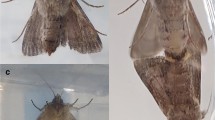Abstract
The pheromone-mediated flight and landing behaviors of maleOstrinia nubilalis were studied in a wind tunnel. The pheromone source was placed in the middle of an 18 × 18-cm horizontal surface, and a smaller surface placed 4, 18, or 36 cm downwind. The smaller surface did not appear to affect significantly the flight tracks or position of landing of males on the upwind surface, and it allowed the positions and altitudes of males as they passed over the downwind surface to be estimated. The flight altitude and position of males as they passed over the downwind surface related to where males landed on the upwind surface. Regardless of the downwind position of the downwind surface, most males flew over its center (i.e., in line with the source) and landed in line with the source on the upwind surface. When a small 2.5 × 10-cm vertical object was placed on the upwind surface, just upwind and to one side of the source, males flew over the downwind surface in positions skewed toward the vertical object and in broader distributions than for the comparable situation without an object: males landed on the upwind surface on positions skewed toward, or on, the object and with a broader distribution (laterally). Flight altitude also corresponded with landing position. Thus, when there was no vertical object, most males flew just above the downwind surface and landed on the downwind edge of the upwind surface. In contrast, with the vertical object, males flew significantly higher and tended to land past the downwind edge of the upwind surface. With a taller object (20 cm), males flew even higher, past the downwind edge and most landed on the vertical object. These data show the close relationship between flight and landing behaviors of maleO. nubilalis and suggest that flight maneuvers that determine track and altitude largely govern where a male lands.
Similar content being viewed by others
References
Baker, T.C. 1989. Pheromones and flight behavior, pp. 231–255,in G.J. Goldsworthy and C.H. Wheeler (eds.), Insect Flight. CRC Press, Boca Raton, Florida.
Charlton, R.E., andCardé, R.T. 1990. Orientation of male gypsy moths,Lymantria dispar (L.), to pheromone sources: the role of olfactory and visual cues.J. Insect Behavior 3:443–469.
Elkinton, J.S., Schal, C., Ono, T., andCarde R.T. 1987. Pheromone puff trajectory and upwind flight of male gypsy moths in a forest.Physiol. Entomol. 12:399–406.
Farkas, S., andShorey, H. 1974. Mechanism of orientation to a distant pheromone source,in M. Birch (ed). Pheromones North Holland, Amsterdam, pp. 81–95.
Farkas, S.R., Shorey, H.H., andGaston, L.K. 1974. Sex pheromones of Lepidoptera. Influence of pheromone concentration and visual cues on aerial odor-trail following by males ofPectinophora gosypiella.Ann. Entomol. Soc. Am. 67:633–638.
Foster, S.P., andHarris, M.O. 1992. Factors influencing the landing of maleEpiphyas postvittana (Walker) exhibiting pheromone-mediated flight.J. Insect Behav. 5:699–720.
Klun, J.A., andHuettel, M.D. 1988. Genetic regulation of sex pheromone production and response: Interaction of sympatric pheromonal types of European corn borer,Ostrinia nubilalis (Lepidoptera: Pyralidae).J. Chem. Ecol. 14:2047–2061.
Klun, J.A. andMaini, S. 1979. Genetic basis of an insect chemical communication system: The European corn borer.Environ. Entomol. 8:423–426.
Klun, J.A., Chapman, O.L., Mattes, K.C., Wojtkowski, P.W., Beroza, M., andSonnet, P.E. 1973. Insect sex pheromones: Minor amount of opposite geometrical isomer critical to attraction.Science 181:661–663.
Kochansky, J., Cardé, R.T., Liebherr, J., andRoelofs, W.L. 1975. Sex pheromone of the European corn borer,Ostrinia nubilalis (Lepidoptera: Pyralidae), in New York.J. Chem. Ecol. 1:225–231.
Kuenen, L.P.S., andBaker, T.C. 1982. The effects of pheromone concentration on the flight behavior of the Oriental fruit moth,Grapholitha molesta.Physiol. Entomol. 7:423–434.
Levinson, H.Z., andHoppe, T. 1983. Preferential flight ofPlodia interpunctella andCadra cautella (Phycitinae) toward figures of definite shape and position with notes on the interaction between optical and pheromone stimuliZ. Angew. Entomol. 96:491–500.
Löfstedt, C., Hansson, B.S., Roelofs, W.L., andBengtsson, B.O. 1989. No linkage between genes determining female pheromone production and male olfactory response in the European corn borerOstrinia nubilalis.Genetics 123:553–556.
Miller, J.R., andRoelofs, W.L. 1978. Sustained-flight tunnel for measuring insect responses to wind-borne sex pheromones.J. Chem. Ecol. 4:187–198.
Murlis, J., Elkington, J.S., andCardé, R.T. 1992. Odor plumes and how insects use them.Annu. Rev. Entomol. 37:505–532.
Preiss, R., andFutschek, L. 1985. Flight stabilization by pheromone-enhanced optomotor responses.Naturwissenschaften 72:435–436.
Preiss, R., andKramer, E. 1983. Stabilization of altitude and speed in tethered flying gypsy moth males: influence of (+) and (-)-disparlure.Physiol. Entomol. 8:55–68.
Preiss, R., andKramer, E. 1986. Pheromone-induced anemotaxis in simulated free flight. pp. 69–79,in T.L. Payne, M.C. Birch, and C.E.J. Kennedy (eds.). Mechanisms in Insect Olfaction. Clarendon Press, Oxford.
Roelofs, W.L., T. Glover, Tang, X.H., Sreng, I., Robbins, P., Eckenrode, C., Löfstedt, C., Hansson, B.S., andBengtsson, B.O. 1987. Sex pheromone production and perception in European corn borer moths is determined by both autosomal and sex-linked genes.Proc. Natl. Acad. Sci. U.S.A. 84:7585–7589.
Wyatt, T.D., Phillips, A.D.G., andGrégoire, J.-C. 1993. Turbulence, trees and semiochemicals: Wind-tunnel orientation of the predator,Rhizophagus grandis, to its bark beetle prey,Dendroctonus micans.Physiol. Entomol. 18:204–210.
Zagatti, P., andRenou, M. 1984. Les phéromones sexualles des zygènes III. Le comportement de Zygaena filipendulae L. (Lepidoptera, Zyganidae).Ann. Soc. Entomol. Fr. 4:439–454.
Author information
Authors and Affiliations
Rights and permissions
About this article
Cite this article
Foster, S.P., Frérot, B. Sex pheromone-mediated flight and landing behaviors of the European corn borer,Ostrinia nubilalis (Hübner). J Chem Ecol 20, 2323–2343 (1994). https://doi.org/10.1007/BF02033206
Received:
Accepted:
Issue Date:
DOI: https://doi.org/10.1007/BF02033206




